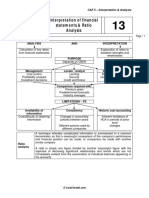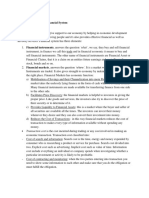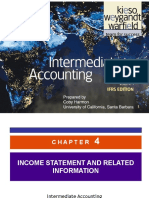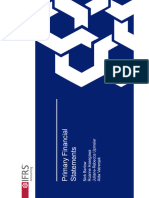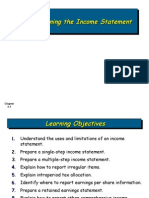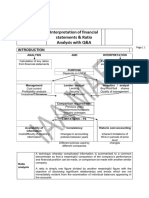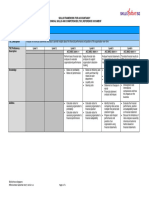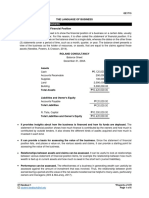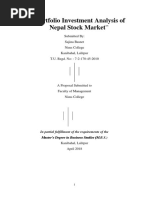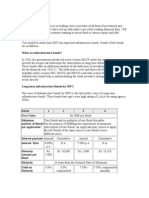Objective: Frs3 Reporting Financial Performance
Objective: Frs3 Reporting Financial Performance
Uploaded by
eugeneCopyright:
Available Formats
Objective: Frs3 Reporting Financial Performance
Objective: Frs3 Reporting Financial Performance
Uploaded by
eugeneOriginal Description:
Original Title
Copyright
Available Formats
Share this document
Did you find this document useful?
Is this content inappropriate?
Copyright:
Available Formats
Objective: Frs3 Reporting Financial Performance
Objective: Frs3 Reporting Financial Performance
Uploaded by
eugeneCopyright:
Available Formats
FRS3 − REPORTING FINANCIAL PERFORMANCE
OVERVIEW
Objective
To explain the need for guidance on reporting performance.
To prescribe the accounting treatment for certain items in the financial
statements.
ACCOUNTING Overview
ISSUES Source of rules
Objective of FRS3 FRS3 REPORTING
FINANCIAL SUMMARY
PERFORMANCE
Impact of items on statements
Relationship between statements
Comprehensive income
PROFIT AND NEW PRIOR PERIOD
LOSS STATEMENTS ADJUSTMENTS
ACCOUNT
Overview Running example Definition
Summary of disclosure Statement of total Steps to record prior
Items included recognised gains and period adjustment
Analysis of results losses
Exceptional items Note of historical cost
Extraordinary items profits and losses
Comparative figures Reconciliation of
movements in
shareholders’ funds
COMPREHENSIVE
EXAMPLE
Accountancy Tuition Centre (Overseas Courses) Ltd 2002 0501
FRS3 − REPORTING FINANCIAL PERFORMANCE
1 ACCOUNTING ISSUES
1.1 Overview
1.1.1 Key questions
The key questions to address are
how well has a company performed?
how well is it likely to perform in future?
how should we present information on financial performance?
1.1.2 Sources of information
The main source of information on financial performance is the profit and loss account
but this does not present a complete picture. Important components of performance,
such as revaluation gains, do not appear in the profit and loss account, but the user of
accounts needs information on these to make a full assessment. Also, users of accounts
need to assess the trend of performance and distinguish one-off or unusual items.
1.1.3 Significance of performance information
Information on performance is important because it influences expectations of future
returns on investments and thus the value of a company’s shares. The primary focus of
investors has traditionally been on earnings per share, which listed companies must
disclose on the face of the profit and loss account. FRS3 has tried to reduce the
emphasis on this by providing a range of performance indicators (the “information
set”) from which readers can make their own assessment.
1.2 Source of rules
FRS3 Reporting financial performance
Companies Act 1985 formats and disclosures
The statutory requirements have already been covered.
Accountancy Tuition Centre (Overseas Courses) Ltd 2002 0502
FRS3 − REPORTING FINANCIAL PERFORMANCE
2 FRS3 REPORTING FINANCIAL PERFORMANCE
2.1 Objective of FRS3
To highlight a range of important components of financial performance…and
provide a basis for assessment of future results and cash flows.
2.1.1 Components of financial performance
These are the various gains and losses which have occurred, ie increases and
decreases in net assets (“ownership interest”), other than those arising because
shareholders have contributed new capital or withdrawn part of their equity as
dividends.
2.1.2 Basis for assessment of future results and cash flows
Need info to help
The value of a business depends largely on expectations of future profits and cash assess trends.
flows. Thus users need information to assess the trend of results.
2.1.3 Summary of key requirements
FRS3 requires
analysis of results: continuing v discontinued operations
some exceptional items to be shown separately on face of P&L a/c
a statement of total recognised gains and losses
a note reconciling reported profit to the historical cost
equivalent, excluding effects of revaluations
a note reconciling movements in shareholders’ funds.
Accountancy Tuition Centre (Overseas Courses) Ltd 2002 0503
FRS3 − REPORTING FINANCIAL PERFORMANCE
3 PROFIT AND LOSS ACCOUNT
3.1 Overview
PROFIT AND
LOSS ACCOUNT
ITEMS ANALYSIS EXCEPTIONAL EXTRAORDINARY COMPARATIVE
INCLUDED OF RESULTS ITEMS ITEMS FIGURES
DISCONTINUED
OPERATIONS
PROVISIONS
PROVISIONS
FOR LOSSES
FOR LOSSES
ON
ON
DISCONTINUANCE
DISCONTINANCE
Accountancy Tuition Centre (Overseas Courses) Ltd 2002 0504
FRS3 − REPORTING FINANCIAL PERFORMANCE
3.2 Summary of disclosure
Profit and loss account
Continuing Discontinued
operations operations
(Acquisitions
separately
identified) down to
operating
profit
down to
operating
profit
Profits/losses on sale or Profits/losses on sale or
termination of operations termination of operations
Exceptional Costs of fundamental
Costs of fundamental items which
reorganisation or reorganisation or
are disclosed restructuring
restructuring separately
Profits/losses on disposal Profits/losses on disposal
of fixed assets of fixed assets
Extraordinary
items
3.3 Items included
Include all gains and losses recognised in the year (ie included in a/cs) in P&L a/c All gains and losses
recognised in year go in
unless required or permitted to go directly to reserves, and therefore shown in P&L a/c unless required
statement of total recognised gains and losses (STRGL). or permitted to go
directly to reserves.
The above requirement to include substantially all gains and losses in the P&L a/c
is sometimes called the “all-inclusive concept”.
Note
FRS3 is not very specific on what should be included in the P&L a/c.
CA85 requires that only realised profits be included in P&L
(realised → company can pay out as dividends).
Accountancy Tuition Centre (Overseas Courses) Ltd 2002 0505
FRS3 − REPORTING FINANCIAL PERFORMANCE
CA85 requirement means that revaluation gains must go to
revaluation reserve (as they are unrealised).
It is normal practice to exclude from the P&L a/c unrealised
losses, such as temporary diminutions arising on fixed asset
revaluations.
Do not recognise gains and losses twice → if gain or loss is recognised in STRGL, Do not recognise gains
and losses twice
do not show again in P&L for any year.
If an increase in value of an asset is recognised by revaluing it, the same gain is not
shown again in the P&L a/c when the asset is sold. Instead, any balance
remaining on the revaluation reserve relating to the asset is transferred to the
P&L reserve as a reserve transfer.
3.4 Analysis of results
Analyse all P&L items from turnover to operating profit between Analyse all P&L items
from T/O to profit
Continuing operations and Discontinued operations
↓
distinguish acquisitions as
a component of continuing
Must analyse turnover and operating profit on face of P&L. Other items Must analyse T/O and
op profit on face of
may be analysed in a note. P&L a/c.
Operating profit is normally profit before income from shares in group
undertakings.
Acquisitions are operations acquired in the period.
3.4.1 Discontinued operations
Discontinued operations are operations sold or terminated within a/c period or by Operations must meet
all criteria to be treated
earlier of 3 months post year end and date of approval of F/S, which meet all of as discontinued
following criteria.
Sale or termination must have material effect on nature and
focus of operations and represent a major reduction in
operating facilities due to withdrawal from a market or
material reduction in turnover from continuing markets.
The nature and focus of operations refers to their positioning in the
market, including quality and location.
Accountancy Tuition Centre (Overseas Courses) Ltd 2002 0506
FRS3 − REPORTING FINANCIAL PERFORMANCE
Assets/liabilities/results must be clearly distinguishable physically,
operationally and for reporting
If a termination, former activities must have ceased permanently.
If any of these conditions is not satisfied, the operations must be treated as
continuing.
Note also
Sale or termination must result from strategic decision to
withdraw or curtail.
Sale or termination primarily to cut costs or increase productivity is part of
continuing operations.
Only income and costs directly related to discontinued operations go under
that heading, not consequential reorganisations in continuing operations.
3.4.2 Provisions for losses on discontinuance
Make provision for operating losses and losses on disposal once decision to sell or Make provision for op
losses and losses on
terminate is made*, unless future trading profits of operation being discontinued are disposal once decision
expected to cover losses, eg on termination. to sell or terminate
made
* ie company is commited to sale/termination, eg binding sale agreement or
detailed formal plan from which company cannot realistically withdraw.
This applies the prudence concept.
Definition of “demonstrably committed”
Either (1) if sale – entered into a binding agreement by
the year end
or (2) if termination – commitment to a detailed
formal plan from which the reporting entity
cannot realistically cancel or withdraw at the
year end.
Provision for loss = Direct costs of + Operating losses up to date
on sale sale/termination of sale/termination
– profit from trading or from
sale of fixed assets
ie provision does not allow
for losses on sale of fixed
assets but , if expected,
prudence and SSAP12
would require separate
provision to be made.
Accountancy Tuition Centre (Overseas Courses) Ltd 2002 0507
FRS3 − REPORTING FINANCIAL PERFORMANCE
Example 1
On 1 July 19X4 Piecemeal plc’s board decided to close its division, which makes and
sells engineering parts, in order to concentrate on its food processing activities. On 30
November 19X4 a formal plan of closure was adopted which is effectively irreversible.
Results of the engineering parts of the business, together with estimates, were as
follows.
(1) Profits and turnover
Operating profits Turnover
Budgeted Actual Actual
at 31.12.X4
1 Jan 19X4 to 30 Nov 19X4 – £4.0m £22m
1 Dec 19X4 to 31 Dec 19X4 – £(0.5m) £2m
1 Jan 19X5 to 31 Jan 19X5 £(0.2m) – –
1 Feb 19X5 to 30 Oct 19X5 £(2.0m) – –
(2) Direct costs of closure (redundancies, contract penalties)
Estimate at 31 December 19X4 £3.0m
Actual incurred in year to 31 December 19X5 £3.1m
(3) Asset values
Losses on sale in 19X5 expected at 31 December 19X4 £1.5m
Actual losses made in 19X5 £0.9m
Required:
Calculate the provision for loss on closure for inclusion in the accounts at 31 December
19X4
Solution 1
Charge to P&L to make the provision for losses goes in continuing operations unless
activities qualify as discontinued in current year.
Accountancy Tuition Centre (Overseas Courses) Ltd 2002 0508
FRS3 − REPORTING FINANCIAL PERFORMANCE
Next year, when activities do qualify as discontinued, results and loss on
termination go in discontinued operations. Release of provision is matched against
operating loss and loss on termination on face of P&L.
Example 2
In 19X2, X plc decides to shut down its manufacturing operations and expects to
incur a loss on closure of £500,000. However, the operations do not qualify as
discontinued in 19X2 as the actual closure is not until May 19X3, when the actual
loss is £600,000.
Required:
Show the accounting entries to make and release the provision.
Solution 2
19X2 £000
£000
Dr
Cr
19X3
Dr
Cr
In 19X3, P&L a/c will show £000
Loss on closure
Provision released
———
Net loss in 19X3
———
Note Provision made is an estimate → actual loss may differ.
Accountancy Tuition Centre (Overseas Courses) Ltd 2002 0509
FRS3 − REPORTING FINANCIAL PERFORMANCE
3.5 Exceptional items
3.5.1 Definition
Material items deriving from events/transactions in ordinary course of business,
which need separate disclosure due to size or incidence for FS to give a true and fair
view.
Items only exceptional
Items are only exceptional if material to the reader of the a/cs. if material.
All activities are
Ordinary activities comprise entity’s business and incidental activities ordinary.
AND effects of events in environment in which it operates, including
political, regulatory, economic and geographical events, irrespective of
frequency or unusual nature.
The definition of ordinary activities is so wide that, in practice, nothing is
likely to fall outside it.
3.5.2 Categories
There are two categories of exceptional item.
(a) Those requiring separate disclosure on face of P&L below operating Analyse 3 types of
exceptional items on
profit, split between continuing and discontinued operations ie face of P&L a/c.
P/L on sale or
termination
profit/loss on sale or termination * costs of fundamental
reorganisation P/L on
costs of fundamental reorganisation or restructuring having a FA disposal (20/21).
material effect on the nature and focus of the reporting entity’s
operations
profit/loss on fixed asset disposal (calculated as proceeds less
net carrying amount).*
* analyse profits and losses separately in note and show effect on tax and
minority interests.
Other exceptional items
(b) Other exceptional items, which go under normal headings with separate disclosed in note and
explained (19).
disclosure in notes. Disclose on face of P&L only if necessary for true and
fair view.
Note should give an adequate description so reader can understand nature
of item.
Accountancy Tuition Centre (Overseas Courses) Ltd 2002 0510
FRS3 − REPORTING FINANCIAL PERFORMANCE
3.6 Extraordinary items
These are material items with a high degree of abnormality, outside ordinary
activities and not expected to recur. Definition
This definition is highly restrictive because ordinary activities are defined so Extraordinary items do
widely. In practice, extraordinary items are extremely rare to the point of being not exist
non-existent, and FRS3 gives no example.
3.7 Comparative figures
Not analysed on face
Face of P&L need show only total figure for comparative; not analysis between
continuing and discontinued operations. However, full analysis of comparatives is
required in notes.
Comparatives must be
consistent with CY
Must restate analysis of comparatives between continuing and discontinued
operations where operation is “discontinued” this year but had been “continuing”
last year.
The consistency concept and the CA require comparatives on a basis consistent
with the current year.
Illustration
19X3 is the current year, 19X2 is the comparative year.
The 19X2 comparative for continuing operations includes
(a) operations classed as continuing in 19X2, and
(b) operations which were acquired in 19X2 and are continuing in 19X3.
The 19X2 comparative for discontinued operations includes
(a) operations classed as discontinued in 19X2, and
(b) operations classed as continuing or that were acquired in 19X2 but which
are classed as discontinued in 19X3.
There will be no 19X2 comparative for acquisitions.
Accountancy Tuition Centre (Overseas Courses) Ltd 2002 0511
FRS3 − REPORTING FINANCIAL PERFORMANCE
4 NEW STATEMENTS
4.1 Running example
Set out below are two items forming part of a set of financial statements.
An extract from a profit and loss account. Statement of res CA85
requirem
The reserve movements note (not required by FRS3). ent, not
FRS3.
As each of the new statements is considered the example is extended and cross
referenced to show how the new statement links in to existing ones.
Profit and loss account for the year ended 31 December 19X3 (extract)
Ref to subsequent examples
Item number £000
(1) Profit on ordinary activities before taxation 39
Tax on profit on ordinary activities (12)
——
(2) Profit for the financial year 27
(3) Dividends ( 9)
——
(4) Retained profit for the financial year 18
——
Notes to the accounts
(1) Statement of movements on reserves
Revaluation Profit and
Total
reserve loss account
£000 £000 £000
At 1 January 19X3
As previously stated 20 70 90
(5) Prior year adjustment – – (5) (5)
—— —— ——
As restated 20 65 85
(6) Goodwill written off – (1) (1)
(7) Surplus on fixed asset revaluation 7 – 7
(8) Transfer of realised profit (2) 2 –
= (4) Retained profit for the financial – 18 18
—— —— ——
At 31 December 19X3 25 84 109
—— —— ——
Accountancy Tuition Centre (Overseas Courses) Ltd 2002 0512
FRS3 − REPORTING FINANCIAL PERFORMANCE
4.2 Statement of total recognised gains and losses
4.2.1 Purpose
To show all gains and losses attributable to shareholders recognised in FS in STRGL shows all gains
and losses attributable to
period. shareholders.
STRGL shows a “range of important components of financial performance” (see
FRS3 objective). Statement gives prominence to gains and losses shown in
statement of reserves and not in the P&L a/c for year, eg revaluations.
4.2.2 Position
STRGL is a primary statement → equal prominence with BS, P&L a/c, CFS. STRGL is a primary
statement.
4.2.3 Items included
Gains and losses attributable to shareholders are
profit for the financial year (before dividends)
revaluation surpluses/deficits not in P&L
prior period adjustments.
Where there are no recognised gains and losses other than the profit or loss for the
year, a statement to this effect on the face of the P&L a/c will satisfy the
requirement for a STRGL.
4.2.4 Items excluded
New share capital issued and dividends to shareholders are not gains and losses New sh cap and divs are
not gains and losses.
attributable to shareholders → not shown in STRGL.
GW w/o on acq is not
Immediate write off of goodwill is not a recognised loss → not included in STRGL. recognised loss
Goodwill is written off as a matter of accounting policy; not due to a diminution in
value.
Accountancy Tuition Centre (Overseas Courses) Ltd 2002 0513
FRS3 − REPORTING FINANCIAL PERFORMANCE
4.2.5 Running example
Statement of total recognised gains and losses for the year ended 31 December 19X3
19X3 Ref to
running example
set up in 4.1
£000
From Item no
Profits for the financial year 27
P&L a/c (2)
Unrealised surplus on revaluation of fixed assets 7
Res movement (7)
——
Total recognised gains and losses relating to the year 34
Prior year adjustment (5)
Res movement (5)
——
Total gains and losses recognised since last annual
report 29
——
4.3 Note of historical cost profits and losses
4.3.1 Requirement and purpose
Needed where result as disclosed and result on an unmodified historical cost (HC) (26,54)
basis are materially different.
Note reconciles reported
Note reconciles reported profit before tax in P&L a/c to pure HC equivalent and profit to pure HC
identifies retained profit for year on HC basis. equivalent.
Reconciliation assists comparison between companies which have revalued their
assets and those which have not.
4.3.2 Position
Present the note of historical cost profits and losses immediately following P&L or Note immediately
follows P&L a/c or
STRGL. STRGL.
4.3.3 Items included
Show profit before tax per P&L a/c and differences from the historical cost equivalent
due to
extra depreciation on revalued assets Differences due to extra
depn and P/L on
disposal of revalued
difference between profit or loss on disposal of revalued asset as reported assets.
in P&L (computed as proceeds less net carrying amount) and HC profit or
loss (proceeds less historical cost NBV).
Also show historical cost retained profit for financial year.
Accountancy Tuition Centre (Overseas Courses) Ltd 2002 0514
FRS3 − REPORTING FINANCIAL PERFORMANCE
4.3.4 Running example
Note of historical cost profits and losses for the year ended 31
December 19X3
19X3 Ref to
running example
set up in 4.1
From Item no
£000
Reported profit on ordinary activities before taxation 39 P&L a/c (1)
Difference between a historical cost depreciation
charge and the actual depreciation charge of the
year calculated on the revalued amount 2 Res movement (8)
—–
Historical cost profit on ordinary activities before
taxation 41
—–
Historical cost profit for the year retained after
taxation and dividends (18 + 2) 20 P&L a/c +
Res movement (4) + (8)
—–
Example 3
A company revalues a fixed asset on 1 January 19X4, giving rise to a surplus of
£34,000. The asset is then depreciated for 19X4, 19X5 and 19X6, giving rise to a
charge £2,000 higher than the historical cost depreciation. On 1 January 19X7, the
asset is sold, giving rise to profit on disposal, based on the revalued NBV of
£15,000. The profit on disposal based on historical cost NBV was £43,000.
Required:
Show how the above information will be reflected in the statement of total
recognised gains and losses, note of historical cost profits and losses and statement
of movements on reserves.
Accountancy Tuition Centre (Overseas Courses) Ltd 2002 0515
FRS3 − REPORTING FINANCIAL PERFORMANCE
Solution 3
Statement of total recognised gains and losses (y/e 31 December 19X4)
£
Surplus on property revaluations
————
Note of historical cost profits and losses (y/es 31 December
19X4, 19X5 and 19X6)
£
Difference between historical cost depreciation and the actual
charge calculated on the revalued amount
————
Note of historical cost profits and losses (y/e 31 December
19X7)
£
Realisation of property revaluation gains of earlier years
————
Statement of movement on reserves (y/es 31 December 19X4, 19X5
and 19X6)
Revaluation Profit and
Total
reserve loss
account
£ £ £
Transfer of realised profit
——— ——— ———
——— ——— ———
4.4 Reconciliation of movements in shareholders’ funds
4.4.1 Definition of shareholders’ funds
Shareholders’ funds comprise all capital and reserves other than minority interests.
They represent the shareholders’ interest in the net assets.
4.4.2 Purpose
To summarise all changes in net assets between the opening and closing BS so that Reconciliation
summarises all changes
the user can distinguish those changes arising due to the company’s financial in NA between opening
performance from other changes in net assets. and closing BS.
4.4.3 Position
Include the reconciliation of movements in shareholders’ funds in the notes to the Include reconciliation in
notes to a/cs
accounts.
Some companies present the reconciliation together with the STRGL and note of
historical cost P&L although this is not strictly required.
Accountancy Tuition Centre (Overseas Courses) Ltd 2002 0516
FRS3 − REPORTING FINANCIAL PERFORMANCE
4.4.4 Items included
Profit for the financial year*
Dividends**
Other gains and losses
Other recognised gains and losses relating to the year, ie overall effect of recognised are shown in
revaluations* STRGL.
New share capital issued**
Goodwill written off directly to reserves***
Opening shareholders’ funds (adjusted for any prior period adjustments)
and closing shareholders’ funds.
* Gains and losses recognised
** Contributions from and distributions to owners
*** Matter of accounting policy
4.4.5 Running example
Notes to the accounts
(2) Reconciliation of movements in shareholders’ funds
19X3 Ref to
running example
set up in 4.1
From Item no
£000
Profit for the financial year 27 P&L a/c (2)
Dividends (9) P&L a/c (3)
——
18
Other recognised gains and losses relating to year (net) 7 Res
movement (7)
Goodwill written off (1) Res
movement (6)
——
Net addition to shareholders’ funds 24
Original
figure
not
derivable
Opening shareholders’ funds (originally £190,000 PYA from
Res
before deducting prior year adjustment of £5,000) 185 movement (5)
——
Closing shareholders’ funds 209
——
Accountancy Tuition Centre (Overseas Courses) Ltd 2002 0517
FRS3 − REPORTING FINANCIAL PERFORMANCE
5 COMPREHENSIVE EXAMPLE
Example 4
Western Enterprise plc wholesales and distributes toys and models. The following
information has been extracted from the first draft of the accounts for the year to 31
December 19X3.
£000
Share capital (including new issue in year of £100,000) 1,300.0
Share premium account (including £200,000 on new issue in
year) 2,600.0
Revaluation reserve 415.0
Profit and loss account at 1 January 19X3 8,569.0
Sales 10,750.0
Purchases and production costs 8,935.0
Stocks at 1 January 19X3 974.0
Staff costs
Distribution 269.5
Other (administration) 351.3
Depreciation
Vehicles 115.5
Other (administration) 171.5
General expenses 233.2
Interest receivable 25.5
Interest payable 33.8
Taxation payable 335.8
Dividends (interim paid) 100.0
Provisions for losses (at 1 January 19X3) 150.0
Additional information
(1) During the year, the company acquired Pioneer Ltd, a distribution
company. Its results since acquisition are already included in the
amounts given. Goodwill arising of £153,800 is to be written off to
reserves.
(2) In May 19X3, the company closed its manufacturing division. The
closure had been announced in 19X2 and a progressive rundown of the
operation had commenced. At 31 December 19X2, losses of £150,000
had been provided for. The final loss on the actual closure was £65,000.
(3) The company revalued premises used in its continuing operations on
1 January 19X3, resulting in a surplus of £262,000. This has been
credited to revaluation reserve but no other entries in this account have
been made since 31 Decenber 19X2. Depreciation charged in the year
increased by £13,800 as a result of revaluations.
(4) General expenses include a bad debt of £100,000 due to the liquidation of
a major customer. This is considered material.
Accountancy Tuition Centre (Overseas Courses) Ltd 2002 0518
FRS3 − REPORTING FINANCIAL PERFORMANCE
Example 4 cont
(5) The company wishes to propose a final dividend of £150,000. Closing
stock is valued at £1,304,000.
(6) Acquisitions and discontinued activities represent the following
proportions of the year’s totals for income and expenses.
% of year’s total
Acquisitions Discontinued
Turnover 25 10
Cost of sales 20 15
Distribution costs 30 10
Administrative expenses 25 20
Required:
Insofar as the information given permits, prepare the following for the year ending
31 December 19X3 using the proformas below.
(a) Consolidated profit and loss account and notes relating to exceptional
items required by FRS3 Reporting financial performance.
(b) Statement of total recognised gains and losses.
(c) Note of historical cost profits and losses.
(d) Statement of reserves.
(e) Reconciliation of movements in shareholders’ funds.
Note Earnings per share and remaining notes are not required. Make all
calculations to the nearest £100.
Accountancy Tuition Centre (Overseas Courses) Ltd 2002 0519
FRS3 − REPORTING FINANCIAL PERFORMANCE
Solution 4
Western Enterprise plc
(a) Consolidated profit and loss account for the year ended 31 December 19X3
Continuing Discontinued Total
operations Acqns operations
Turnover £000 £000 £000 £000
Cost of sales
——— ——— ——— ———
Gross profit/(loss)
Distribution costs
Administrative expenses
——— ——— ——— ———
Operating profit/(loss) (note 1)
Loss on disposal of
discontinued operations
Less 19X2 provision
——— ——— ——— ———
Profit on ordinary activities
before interest
——— ——— ———
Other interest receivable and similar income
Interest payable and similar charges
———
Profit on ordinary activities before taxation
Tax on profit on ordinary activities
———
Profit for the financial year
Dividends
———
Retained profit for the financial year
———
Note 1 Operating profit is after charging £000
———
(b) Statement of total recognised gains and losses
£000
Profit for the financial year
Unrealised surplus on revaluation of properties
———
Total recognised gains and losses relating to the year
———
Accountancy Tuition Centre (Overseas Courses) Ltd 2002 0520
FRS3 − REPORTING FINANCIAL PERFORMANCE
(c) Note of historical cost profits and losses
£000
Reported profit on ordinary activities before taxation
Difference between historical cost depreciation charge and the
actual charge for the year calculated on the revalued amount
———
Historical cost profit on ordinary activities before taxation
———
Historical cost profit for the year retained after
taxation, minority interests, and dividends
———
(d) Statement of reserves
Share Profit
premium Revaluation and loss
account reserve account Total
£000 £000 £000 £000
At 1 January 19X3
Premium on issue of shares
(nominal value )
Goodwill written off
Transfer from profit and
loss account of the year
Transfer of realised profits
Surplus on property
revaluations
——— ——— ——— ———
At 31 December 19X3
——— ——— ——— ———
(e) Reconciliation of movements in shareholders’ funds
£000
Profit for the financial year
Dividends
———
Other recognised gains and losses relating to the year
New share capital subscribed
Goodwill written off
———
Net addition to shareholders’ funds
Opening shareholders’ funds
———
Closing shareholders’ funds
———
WORKING
£000
Cost of sales
Distribution costs
Administrative expenses
Accountancy Tuition Centre (Overseas Courses) Ltd 2002 0521
FRS3 − REPORTING FINANCIAL PERFORMANCE
6 PRIOR PERIOD ADJUSTMENTS
6.1 Definition
Prior period adjustments (also called “prior year adjustments”) are material PPA only due to
changes in accg policy
adjustments applicable to prior periods arising only due to or correction of
fundamental errors
changes in accg policy, or
correction of fundamental errors.
They are NOT recurring adjustments or revision of estimates.
Definition is narrow and, in practice, prior period adjustments are rare.
6.1.1 Consistency
Consistency year-on-year is a fundamental concept in SSAP2. Apply consistency
concept.
If this year’s accounts are prepared on a basis which is inconsistent with
last year
− the comparatives must be restated, and
− the new basis reconciled to the old.
CA85 requires comparatives on basis consistent with current year.
6.1.2 Change in accounting policy
Permitted only if new one gives fairer presentation. Change in accg policy
permitted only if new
policy gives fairer
presentation
This usually arises when a new accounting standard is issued or where an existing
standard allows a choice and the company switches from one option to the other, eg
SSAP13 in relation to development costs.
Distinguish change in accg policy from Distinguish from
revision of estimates.
change in estimate, eg useful economic life, outcome of development
project
refinement of accg policy, eg if business moves into new area.
6.1.3 Fundamental errors
These are extremely rare and are so large that they destroy the true and fair view. Fundamental errors
extremely rare
In an exam question, you are likely to be told if an error is fundamental.
Accountancy Tuition Centre (Overseas Courses) Ltd 2002 0522
FRS3 − REPORTING FINANCIAL PERFORMANCE
6.2 Steps to record prior period adjustment
(1) Restate opening balances for current year and apply new
basis in preparing current year’s a/cs.
(2) Adjust comparative figures.
6.2.1 Opening balances for current year
Calculate what amounts would have been in opening BS for current year on new PPA appears in
statement of reserves,
basis. Difference in opening net assets for current year compared to the old basis STRGL, and
gives the prior period adjustment to reconciliation of
shareholders’ funds.
opening reserves for current year, shown in the statement of reserves and
in the STRGL
opening shareholders’ funds in the reconciliation of movements in
shareholders’ funds, and
BS comparatives in current year’s a/cs.
6.2.2 Comparative figures
Calculate the adjustment to restate P&L a/c comparative figures for previous year
and show adjusted figures as comparatives in current year’s a/cs.
Also restate P&L a/c
Also need a note to the accounts to explain the adjustment and its effect on profits in comparatives.
the current year. Note to explain
adjustment.
Accountancy Tuition Centre (Overseas Courses) Ltd 2002 0523
FRS3 − REPORTING FINANCIAL PERFORMANCE
Example 5
Conglom Ltd’s balance sheet for 19Y2 shows the following.
£
Freehold property – cost 100,000
Other net assets 60,000
————
160,000
————
Share capital 40,000
Retained profits
Brought forward 110,000
Retained for the year 10,000
————
160,000
————
At the end of 19Y2 Conglom Ltd changed its accounting policy so that depreciation
is provided on freehold property at 1% per annum on cost. The above property was
purchased at the beginning of 19X1.
Required:
Redraft the above to reflect this change.
Accountancy Tuition Centre (Overseas Courses) Ltd 2002 0524
FRS3 − REPORTING FINANCIAL PERFORMANCE
Solution 5
Conglom Ltd: Balance sheet as at 31 December 19Y2
£ £
Freehold property
– cost
– accumulated depreciation
———
Other net assets
————
————
Share capital
Retained profits
Brought forward
Prior period adjustment
————
As restated
Retained for the year
————
————
————
Accountancy Tuition Centre (Overseas Courses) Ltd 2002 0525
FRS3 − REPORTING FINANCIAL PERFORMANCE
7 SUMMARY
7.1 Impact of items on statements
Statement STRGL Note of Reconciliation
of reserves HC P&L of s/h funds
Revaluation of
fixed asset In total of
other gains
and losses
Extra depreciation
due to revaluation
Remaining
revaluation surplus
on asset now sold
Immediate write-
off of goodwill
Issue of shares
Premium Proceeds
Prior period
adjustment Adjust
opening s/h
funds
7.2 Relationship between statements
The statement of total recognised gains and losses, note of historical cost profits and
losses and reconciliation of movements in shareholders’ funds do not form part of the
double-entry. They all summarise or re-present information which is also shown in the
profit and loss account or statement of reserves.
7.3 Comprehensive income
Comprehensive income is a broad concept of an enterprises financial performance, in
that it includes all changes in equity, from transactions and other events and
circumstances from non-owner sources, of a business enterprise during an accounting
period.
The only changes in equity that are excluded from comprehensive income are
distributions to, and investments by owners.
Accountancy Tuition Centre (Overseas Courses) Ltd 2002 0526
FRS3 − REPORTING FINANCIAL PERFORMANCE
The statement of recognised gains and losses is an example of disclosing
comprehensive income. Alternatively the profit and loss account may be combined
with the other gains and losses in one statement to show comprehensive income.
Illustration 2
$ $
Revenue 2,000
Expenses (1,750)
Profit before tax 250
Tax (100)
Profit after tax 150
Other comprehensive income – net of tax
- unrealised holding gains 30
- foreign currency translation losses (5) 25
Comprehensive income 175
OR
Net income 150
Other comprehensive income – net of tax
- unrealised holding gains 30
- foreign currency translation losses (5)
Comprehensive income 175
Accountancy Tuition Centre (Overseas Courses) Ltd 2002 0527
FRS3 − REPORTING FINANCIAL PERFORMANCE
FOCUS
You should now be able to:
Explain the need for an accounting standard in this area;
Define and discuss the importance of discontinuing operations;
Distinguish between and be able to account for exceptional and extraordinary
items;
Prepare a profit and loss account in accordance with FRS 3;
Explain the contents and purpose of the statement of total recognised gains
and losses, linking it to the statement of principles and the concept of
comprehensive income;
Describe and prepare:
a note of historical cost profits and losses;
reconciliation of movements in shareholders funds;
statement of movement on reserves;
Define prior period adjustments and account for the correction of
fundamental errors and changes in accounting policies;
Outline the concept of comprehensive income.
Accountancy Tuition Centre (Overseas Courses) Ltd 2002 0528
FRS3 − REPORTING FINANCIAL PERFORMANCE
EXAMPLE SOLUTIONS
Solution 1
Provision for loss = Direct costs of closure + Operating losses up,to date of closure
£5.2m = 3 + (0.2 + 2)
———
Note Loss on sale of fixed assets would be provided for separately within operating
profit.
Solution 2
19X2 £000 £000
Dr P&L Continuing operations ‘Provisions for losses on
operations to be discontinued’ 500
Cr B/S Provisions for liabilities and charges 500
19X3
Dr B/S Provisions for liabilities and charges 500
Cr P&L Discontinued operations ‘Provisions for losses
on operations to be discontinued 500
In 19X3, P&L a/c will show £000
Loss on closure 600
Provision released (500)
———
Net loss in 19X3 100
———
Accountancy Tuition Centre (Overseas Courses) Ltd 2002 0529
FRS3 − REPORTING FINANCIAL PERFORMANCE
Solution 3
Statement of total recognised gains and losses (y/e 31 December 19X4)
£
Surplus on property revaluations 34,000
———
Note of historical cost profits and losses
(y/es 31 December 19X4, 19X5 and 19X6)
£
Difference between historical cost depreciation and the actual
charge calculated on the revalued amount 2,000
———
Note of historical cost profits and losses (y/e 31 December 19X7)
£
Realisation of property revaluation gains of earlier years 28,000
———
Statement of movement on reserves (y/es 31 December 19X4, 19X5 and 19X6)
Revaluation Profit and
Total
reserve loss
account
£ £ £
Transfer of realised profit (2,000) 2,000 –
——— ——— ———
(2,000) 2,000 –
——— ——— ———
Accountancy Tuition Centre (Overseas Courses) Ltd 2002 0530
FRS3 − REPORTING FINANCIAL PERFORMANCE
Solution 4
Western Enterprise plc
(a) Consolidated profit and loss account for the year ended 31 December 19X3
Continuing operations
Discontinued Total
Acquisitions
operations
£000 £000 £000 £000
Turnover (split 65:25:10) 6,987.5 2,687.5 1,075.0 10,750.0
Cost of sales (W) (5,593.2) (1,721.0) (1,290.8) (8,605.0)
———— ———— ———— ————
Gross profit/(loss) 1,394.3 966.5 (215.8) 2,145.0
Distribution costs (W) (231.0) (115.5) (38.5) (385.0)
Administrative expenses (W) (415.8) (189.0) (151.2) (756.0)
———— ———— ———— ————
Operating profit/(loss) (note 1) 747.5 662.0 (405.5) 1,004.0
Loss on disposal of
discontinued operations – – (65.0) (65.0)
Less 19X2 provision – – 150.0 150.0
———— ———— ———— ————
Profit on ordinary activities
before interest 747.5 662.0 (320.5) 1,089.0
———— ———— ———— ————
Other interest receivable and similar income 25.5
Interest payable and similar charges (33.8)
————
Profit on ordinary activities before taxation 1,080.7
Tax on profit on ordinary activities (335.8)
————
Profit for the financial year 744.9
Dividends (250.0)
————
Retained profit for the financial year 494.9
————
Note 1 Operating profit is after charging £000
Exceptional bad debt write off due to liquidation of a customer 100.0
————
Accountancy Tuition Centre (Overseas Courses) Ltd 2002 0531
FRS3 − REPORTING FINANCIAL PERFORMANCE
(b) Statement of total recognised gains and losses
£000
Profit for the financial year 744.9
Unrealised surplus on revaluation of properties 262.0
————
Total recognised gains and losses relating to the year 1,006.9
————
(c) Note of historical cost profits and losses
£000
Reported profit on ordinary activities before taxation 1,080.7
Difference between historical cost depreciation charge and
the actual charge for the year calculated on the revalued amount 13.8
————
Historical cost profit on ordinary activities before taxation 1,094.5
————
Historical cost profit for the year retained after taxation,
minority interests, and dividends (494.9+13.8) 508.7
————
(d) Statement of reserves
Share Profit
premium Revaluation and loss
account reserve account Total
£000 £000 £000 £000
At 1 January 19X3 2,400.0 153.0 8,569.0 11,122.0
Premium on issue of shares
(nominal value £100,000) 200.0 – – 200.0
Goodwill written off – – (153.8) (153.8)
Transfer from profit and loss
account of the year – – 494.9 494.9
Transfer of realised profits – (13.8) 13.8 –
Surplus on property revaluations – 262.0 – 262.0
———— ———— ———— ————
At 31 December 19X3 2,600.0 401.2 8,923.9 11,925.1
———— ———— ———— ————
(e) Reconciliation of movements in shareholders’ funds
£000
Profit for the financial year 744.9
Dividends (250.0)
————
494.9
Other recognised gains and losses relating to the year 262.0
New share capital subscribed (100 + 200) 300.0
Goodwill written off (153.8)
————
Net addition to shareholders’ funds 903.1
Opening shareholders’ funds (1,200 + 2,400 +153 + 8,569) 12,322.0
————
Closing shareholders’ funds 13,225.1
————
Accountancy Tuition Centre (Overseas Courses) Ltd 2002 0532
FRS3 − REPORTING FINANCIAL PERFORMANCE
WORKING
£000
Cost of sales (974 + 8,935 – 1,304) split 65:20:15 8,605
Distribution costs ( 269.5 + 115.5) split 60:30:10 385
Administrative expenses (351.3 + 171.5 + 233.2) split 55:25:20 756
Solution 5
Conglom Ltd
Balance sheet as at 31 December 19Y2
£ £
Freehold property
– cost 100,000
– accumulated depreciation (12,000)
———–
88,000
Other net assets 60,000
———–
148,000
———–
£
Share capital 40,000
Retained profits
Brought forward 110,000
Prior period adjustment (11,000)
———–
As restated 99,000
Retained for the year 9,000
———–
108,000
–———
148,000
–———
Accountancy Tuition Centre (Overseas Courses) Ltd 2002 0533
FRS3 − REPORTING FINANCIAL PERFORMANCE
Accountancy Tuition Centre (Overseas Courses) Ltd 2002 0534
You might also like
- English For Accounting - Student's Book PDFDocument62 pagesEnglish For Accounting - Student's Book PDFPaqui Nicolas100% (3)
- Schaum's Outline of Principles of Accounting I, Fifth EditionFrom EverandSchaum's Outline of Principles of Accounting I, Fifth EditionRating: 5 out of 5 stars5/5 (3)
- Orca Share Media1547030319812Document523 pagesOrca Share Media1547030319812Maureen Joy Andrada80% (10)
- Interpretation of Financial Statements & Ratio AnalysisDocument35 pagesInterpretation of Financial Statements & Ratio Analysisamitsinghslideshare67% (3)
- F2 Revision SummariesDocument97 pagesF2 Revision Summarieswakomoli100% (2)
- MAS 2 Grp1 Written ReportDocument12 pagesMAS 2 Grp1 Written ReportRenda QiutiNo ratings yet
- 05 Ratios and Trend AnalysisDocument11 pages05 Ratios and Trend AnalysisHaris IshaqNo ratings yet
- Topic 3 Lecture 1 24 25 copyDocument41 pagesTopic 3 Lecture 1 24 25 copykbqb6m7rhsNo ratings yet
- Examining The Income Statement Examining The Income StatementDocument49 pagesExamining The Income Statement Examining The Income StatementSaiful Islam KhanNo ratings yet
- Solution Manual Chapter 4 Intermediate Accounting - KIYOSIDocument13 pagesSolution Manual Chapter 4 Intermediate Accounting - KIYOSIIndra AminudinNo ratings yet
- Intermediate Power PointDocument50 pagesIntermediate Power Pointlow profileNo ratings yet
- Income Statement - Kieso 4Document34 pagesIncome Statement - Kieso 4Muhammad RezaNo ratings yet
- 4-Ch 4 - IFRS-wDocument19 pages4-Ch 4 - IFRS-wFAEETNo ratings yet
- The Income Statements: Teori AkuntansiDocument25 pagesThe Income Statements: Teori AkuntansirifaNo ratings yet
- TM 7 Akkeu 1Document49 pagesTM 7 Akkeu 1Jasmine Putri FaradhisaNo ratings yet
- ch04 PDFDocument73 pagesch04 PDFHanna UnnailiNo ratings yet
- Topic 3 Lecture 1 24 25 copy 6Document30 pagesTopic 3 Lecture 1 24 25 copy 6kbqb6m7rhsNo ratings yet
- ch04.ppt - Income Statement and Related InformationDocument68 pagesch04.ppt - Income Statement and Related InformationAmir ContrerasNo ratings yet
- Accounting: Quantitative Information Primarily Financial inDocument19 pagesAccounting: Quantitative Information Primarily Financial inleeeydoNo ratings yet
- IRFS Notes Part 4Document31 pagesIRFS Notes Part 4Deandre DreyerNo ratings yet
- Level1 FSA Reading34Document92 pagesLevel1 FSA Reading34Abid WaheedNo ratings yet
- Lecture ONE Accounting For ManagerDocument30 pagesLecture ONE Accounting For Managermohamed elsabahiNo ratings yet
- Financial Accounting Review SlidesDocument10 pagesFinancial Accounting Review SlidesPalak SinghNo ratings yet
- Minggu 12 - BAB 12 - Kelompok 1Document25 pagesMinggu 12 - BAB 12 - Kelompok 1rifaNo ratings yet
- Fa 116Document165 pagesFa 116eliheydergasimovNo ratings yet
- Ind AS 1Document69 pagesInd AS 1ShishirNo ratings yet
- Kieso - IFRS - ch04 - IFRS (Income Statement)Document73 pagesKieso - IFRS - ch04 - IFRS (Income Statement)Muzi RahayuNo ratings yet
- Examining The Income StatementDocument44 pagesExamining The Income Statementsueern100% (1)
- 01 SoF Lecture 1 - Financial Statement AnalysisDocument86 pages01 SoF Lecture 1 - Financial Statement AnalysisbradleylloydrileyNo ratings yet
- Ch03_I_Income stat & related info(1)Document70 pagesCh03_I_Income stat & related info(1)natiman8399No ratings yet
- Week 10 LectureDocument19 pagesWeek 10 Lecturejiejialing08No ratings yet
- 1FINALInvestmentTopic-7to-9Document7 pages1FINALInvestmentTopic-7to-9Chyriel BaconguisNo ratings yet
- Chapter 3 2023Document7 pagesChapter 3 2023Linh DieuNo ratings yet
- Topic 4 Lecture 1 2Document27 pagesTopic 4 Lecture 1 2kbqb6m7rhsNo ratings yet
- Income Statement and Related Information: Intermediate AccountingDocument64 pagesIncome Statement and Related Information: Intermediate AccountingAdnan AbirNo ratings yet
- Reporting For Segments and For Interim Financial Periods: Advanced Accounting, Fifth EditionDocument42 pagesReporting For Segments and For Interim Financial Periods: Advanced Accounting, Fifth EditionHeaven NamjoonNo ratings yet
- FRA IntroductionDocument1 pageFRA Introductionmaimaitaan120201No ratings yet
- IfrsDocument29 pagesIfrsSamer BrownNo ratings yet
- Sap - Financial Statement PlanningDocument28 pagesSap - Financial Statement PlanningRobert van MeijerenNo ratings yet
- SBRIFRS5 TutorSlidesDocument24 pagesSBRIFRS5 TutorSlidesDipesh MagratiNo ratings yet
- ch04 Income StatementDocument76 pagesch04 Income StatementFachrurrozie UnnesNo ratings yet
- AKM 1 - CH 4Document76 pagesAKM 1 - CH 4Fauziah AbdunnafiNo ratings yet
- CH 04Document59 pagesCH 04grace maylaniNo ratings yet
- ACCT10001 Tutorial 5Document29 pagesACCT10001 Tutorial 5aaronso1211No ratings yet
- Chapter 7Document18 pagesChapter 7Phương KhanhNo ratings yet
- LN To MFRS3Document40 pagesLN To MFRS3michelleNo ratings yet
- Assignment Brief APDocument4 pagesAssignment Brief APmudassar saeed100% (1)
- (SAPP Academy) Tóm Tắt Kiến Thức Quan Trọng Môn FAF3 ACCADocument201 pages(SAPP Academy) Tóm Tắt Kiến Thức Quan Trọng Môn FAF3 ACCAhuyentran phamNo ratings yet
- Chapter 14 Audit Reporting Summary-1Document9 pagesChapter 14 Audit Reporting Summary-1Angelyn UrbisoNo ratings yet
- CH 04Document81 pagesCH 04la ziiNo ratings yet
- Ratio Analysis Q&a MAFDocument23 pagesRatio Analysis Q&a MAFmohedNo ratings yet
- Lecture 2 - Statement of Comprehensive IncomeDocument52 pagesLecture 2 - Statement of Comprehensive IncomeGonzalo Jr. RualesNo ratings yet
- Focused On Outcomes: Rated By: PACRA & VISDocument234 pagesFocused On Outcomes: Rated By: PACRA & VISFahimNo ratings yet
- Financial Statements: An Introduction ToDocument45 pagesFinancial Statements: An Introduction ToHazel Joy DemaganteNo ratings yet
- 1a - DIVISIONAL PERFORMANCEDocument48 pages1a - DIVISIONAL PERFORMANCEAQILAH SALSABILA AZMINo ratings yet
- 1Document62 pages1ShuvO DeYNo ratings yet
- Full Set of FSDocument68 pagesFull Set of FSMary Joy VallarNo ratings yet
- 4 Financial AnalysisDocument1 page4 Financial AnalysisHana DwiNo ratings yet
- Analysis of Reformulated Financial StatementsDocument46 pagesAnalysis of Reformulated Financial StatementsAkib Mahbub KhanNo ratings yet
- Wiley CMAexcel Learning System Exam Review 2017: Part 1, Financial Reporting, Planning, Performance, and Control (1-year access)From EverandWiley CMAexcel Learning System Exam Review 2017: Part 1, Financial Reporting, Planning, Performance, and Control (1-year access)No ratings yet
- Equity Valuation: Models from Leading Investment BanksFrom EverandEquity Valuation: Models from Leading Investment BanksJan ViebigNo ratings yet
- How Insurtech Can Close The Protection Gap in Emerging MarketsDocument8 pagesHow Insurtech Can Close The Protection Gap in Emerging MarketseugeneNo ratings yet
- GRAMMAR Present SimpleDocument5 pagesGRAMMAR Present SimpleeugeneNo ratings yet
- GRAMMAR Present SimpleDocument5 pagesGRAMMAR Present SimpleeugeneNo ratings yet
- Powerpoint 2016Document23 pagesPowerpoint 2016eugeneNo ratings yet
- International Banking: Brief Introduction To Mergers & AcquisitionsDocument29 pagesInternational Banking: Brief Introduction To Mergers & AcquisitionseugeneNo ratings yet
- ICM Level 3 Diploma in Credit Management: The Faculty of Business & Law The Insitute of Credit ManagementDocument4 pagesICM Level 3 Diploma in Credit Management: The Faculty of Business & Law The Insitute of Credit ManagementeugeneNo ratings yet
- Unit 3 PDFDocument72 pagesUnit 3 PDFeugeneNo ratings yet
- Unit Understanding E-CommerceDocument5 pagesUnit Understanding E-CommerceeugeneNo ratings yet
- Course Outline - Investment Analysis and Portfolio ManagementDocument2 pagesCourse Outline - Investment Analysis and Portfolio ManagementAdnan Khan100% (1)
- Study - Guide Income Statement To Cash FlowDocument17 pagesStudy - Guide Income Statement To Cash FlowThgayNo ratings yet
- ScienceDirect Citations 1522851638967Document42 pagesScienceDirect Citations 1522851638967Manoj KumarNo ratings yet
- Mutual Fund TATA - Security AnalysisDocument15 pagesMutual Fund TATA - Security AnalysisHarish YaduvanshiNo ratings yet
- Ambit - Strategy - India's Best and Worst Capital AllocatorsDocument32 pagesAmbit - Strategy - India's Best and Worst Capital Allocatorsinvestmentcalls100% (1)
- A Research Paper by Mayur ShahDocument9 pagesA Research Paper by Mayur Shahmk singhNo ratings yet
- Understanding Financial Statements: Student - Feedback@sti - EduDocument6 pagesUnderstanding Financial Statements: Student - Feedback@sti - Eduvince mendozaNo ratings yet
- CM17479 Property Market Review - New OfficeDocument7 pagesCM17479 Property Market Review - New OfficeBichon OttawaNo ratings yet
- Investment PDFDocument15 pagesInvestment PDFLenrey Cobacha100% (1)
- Consolidated Financial Statements Indonesian Institute of AccountantsDocument10 pagesConsolidated Financial Statements Indonesian Institute of Accountantshakoe999No ratings yet
- Jun18l1eth-C02 QaDocument7 pagesJun18l1eth-C02 Qarafav10No ratings yet
- Sant Goben Ratio (FINAL)Document64 pagesSant Goben Ratio (FINAL)Mihir ShahNo ratings yet
- Portfolio Investment Analysis Of: Nepal Stock MarketDocument11 pagesPortfolio Investment Analysis Of: Nepal Stock MarketDipenNo ratings yet
- IDFC BondDocument3 pagesIDFC BondKeisham BabitaNo ratings yet
- A3 Long ProblemDocument1 pageA3 Long ProblemJohn Rey Bantay RodriguezNo ratings yet
- KPMG 08 Share-Based Payments Comparison US To IFRSDocument12 pagesKPMG 08 Share-Based Payments Comparison US To IFRSMary Grace Caguioa AgasNo ratings yet
- eFM2e, CH 10, SlidesDocument32 pageseFM2e, CH 10, SlidesDanica BeleyNo ratings yet
- Chapter 6Document26 pagesChapter 6Annalyn MolinaNo ratings yet
- MindmapDocument6 pagesMindmapapi-302359373No ratings yet
- Case Study - Financial MarketsDocument3 pagesCase Study - Financial MarketsRazel TercinoNo ratings yet
- ICICIdirect MonthlyMFReport PDFDocument15 pagesICICIdirect MonthlyMFReport PDFArijit ChakrabortyNo ratings yet
- The 10 Best Momentum Chart PatternsDocument42 pagesThe 10 Best Momentum Chart PatternsNicola Duke100% (8)
- LPPF 4q18 - NomuraDocument6 pagesLPPF 4q18 - Nomurakrisyanto krisyantoNo ratings yet
- Balance Sheet Annual of Jollibee Food CorporationDocument2 pagesBalance Sheet Annual of Jollibee Food CorporationJan Harvey Rivera BalingaoNo ratings yet
- Money 2014-07 PDFDocument78 pagesMoney 2014-07 PDFAcraaNo ratings yet
- Financial Performance of The Nokia Corporation Finance EssayDocument30 pagesFinancial Performance of The Nokia Corporation Finance EssayHND Assignment HelpNo ratings yet
- CEM Article - The Time Has Come For Standardized Total Cost Disclosure For Private EquityDocument9 pagesCEM Article - The Time Has Come For Standardized Total Cost Disclosure For Private EquityeliforuNo ratings yet
- Attracting Angel InvestorsDocument3 pagesAttracting Angel InvestorsJeyashankar RamakrishnanNo ratings yet
- Derivatives and Risk ManagementDocument5 pagesDerivatives and Risk ManagementabhishekrameshnagNo ratings yet



